 Institute of Archaeology Institute of Archaeology |
[Slovenian] |
| Home | Members | Programme | Projects | Laboratory |
| Database | Publications | Library | Links | Archive |
|
Programme - The La Tène Period 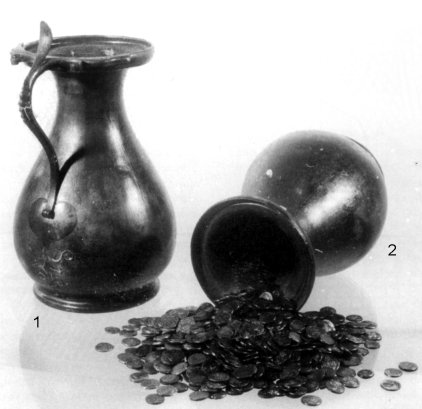
LATE LA TÈNE ROMAN CEMETERY AT NOVO MESTO
Preparation of the publication of the Late La Tene Roman graves at the sites of Ljubljanska cesta and Okrajno glavarstvo in Novo mesto, which belong to the cemetery of Beletov vrt. Until now only a few of the finds, excavated in the years 1890 and 1902 and kept in the National Museum of Slovenia, have been published. The grave assemblages are not known. Apart from one from the early Hallstatt period, all the graves belonged to the time span from the Late La Tène to the 4th century AD. Contact: dr. Dragan Božič SOČA REGION IN THE LA TÈNE PERIOD The reconstruction and analysis of the Late La Tène hoard of iron tools from Vrhovlje pri Kojskem The reconstruction of the Late La Tène hoard of iron tools from Vrhovlje pri Kojskem, which also appears in the printed and manuscript sources as well as on the internet (www.obcina-kanal.si/index.php?vie=cnt&gr1=pRds&gr2=zGdv) under the names Plave and martno pri Kojskem. The majority of the references and publications made to date described its composition inaccurately. The most recent incorrect reference to it, with an inadequate citation of the sources, was by Isabel Ahumada Silva in the exhibition catalogue Gli echi della terra (Pisa 2002) 83. The tools, found in 1891, are in the Regional Museum of Gorizia. The reconstruction of the hoard was enabled by a letter, preserved in the archives of Vienna, which was sent to the Central Commission by Prof. Heinrich Maionica, director of the Regional Museum and curator. Four of five objects are preserved: a ploughshare, two pointed hoes and an axe with one-sided wings. The meat fork is lost, but Maionica made a drawing of it in his letter. Cfr. S. Petru in: Arheoloka najdiča Slovenije (Ljubljana 1975) 124 under Plave; M. Gutin, Posočje (Ljubljana 1991) 28 and D. Božič in: Zakladi tisočletij (Ljubljana 1999) 180 with figure. The preserved tools are exposed in the glass case Late Iron Age Late La Tène period in the permanent archaeological exhibition on the Castle Hill at Gorizia (www.museifriuliveneziagiulia.it/scheda_museo.html?id=2). The first, the second, the fourth and the sixth object in the upper row, counting from right to left, belong to the hoard.
Publication: D. BOIČ, The reconstruction and analysis of the Late La Tène hoard of iron tools from Vrhovlje pri Kojskem above the Soča valley. - V: Le valli del Natisone e dell'Isonzo tra Centroeuropa e Adriatico, Studi e ricerche sulla Gallia Cisalpina (Roma 2006 - v tisku).
Contact: dr. Dragan Božič Silver jewellery of Iron Age women in the Friuli plain and in the Soča region At the end of the Hallstatt period in the Friuli plain the most precious jewellery was represented by big silver Certosa fibulae with a bow bent into a knee-shape. Two out of four such fibulae, sold in 1891 in London at the auction of the collection of Dr. S. Egger from Vienna, are now kept at the Museum of Fine Arts in Budapest. On the provisory permanent exposition Treasures of the National Museum of Slovenia a luxurious silver three-knobbed-torc from the Soča region is displayed. Two similar silver torcs were found near Idrija pri Bači by 1869 or earlier. Next to torcs and fibulae, band earrings of bronze sheet, decorated by embossed bosses and small round plates of silver between them, are typical of Late La Tène female costume in the Soča region.
Contact: dr. Dragan Božič On the dating of the iron tridents from Reka in the Idrijca valley On the settlement Grad near Reka a metal detector searcher has found an iron trident with points of a rhombic section and a winged shaft part. A similar trident lay in one of the graves discovered in 1883 on the nearby site of Kozarska. This trident is very probably the one now displayed on the Castle Hill of Gorizia. Considering the comparisons from Crkvina in Makljenovac in Bosnia and from Sanzeno in the Trento region, the tridents from Reka very probably belong to the Late La Tène period. The fish spear with eleven points, ascribed by Mitja Gutin in 1975 to the presumably Late La Tène hoard from Rubije near the Vipava River, is in fact from the 18th or 19th century. Such fish spears were used for eel fishing.
Contact: dr. Dragan Božič NON-CERAMIC FINDS OF THE LA TÈNE PERIOD D-shaped buckle from the horse grave at Kobarid
As well as a curb bit and a spur of Mediterranean type, the Late La Tène horse grave from Kobarid contained a D-shaped bronze buckle with a broken-off hook. Numerous horse graves from the Lower Danube region prove that such buckles were not attached to belts, but to the straps of the harness. Two D-shaped buckles from the tomb of the Macedonian king Philippus II, wrongly interpreted by some Greek archaeologists as spurs of a special kind, had the same function.
Publication D. BOIČ, The function of the bronze D-shaped ring from the Late Republican horse burial in Kobarid, Soča valley (SI). - Instrumentum 20, déc. 2004, 6-8. On the typology and chronology of Late Republican bronze strainers
The typological-chronological division of the Late Republican strainers made by French archaeologist Jean-Paul Guillaumet has until recently been valid, but should now be fundamentally corrected. On the basis of a new typological division of thumb-rests and finger-rests and of a chronological analysis of the find complexes it can be proved that some variants are not Late Republican at all, but Early Imperial.
Contact: dr. Dragan Božič IRON AGE CEMETERIES NEAR MOKRONOG
A publication concerning the cemeteries belonging to the Iron Age settlement on Križni vrh hill near Mokronog is in preparation. The cemeteries extend from Božji grob above Slepek to Vidmarjeva hosta above Ribjek and were excavated by Jernej Pečnik in the years 1885-1888. The grave assemblages are not preserved. The finds, kept in the prehistoric collection of the National Museum of Slovenia in Ljubljana, belong to the time from the phase Podzemelj to the phase Mokronog IIIa (= LT D1). Although until now, only Late La Tène finds have come to light in the settlement; the grave finds also belong to the end of the Early and to the Middle La Tène period, that is, in the phases Mokronog I, IIa and IIb.
Contact: dr. Dragan Božič |

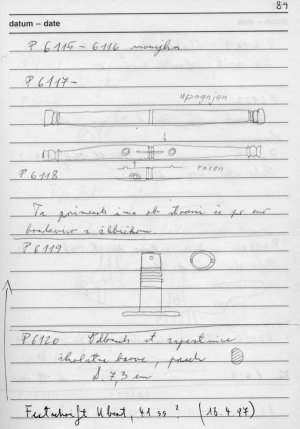
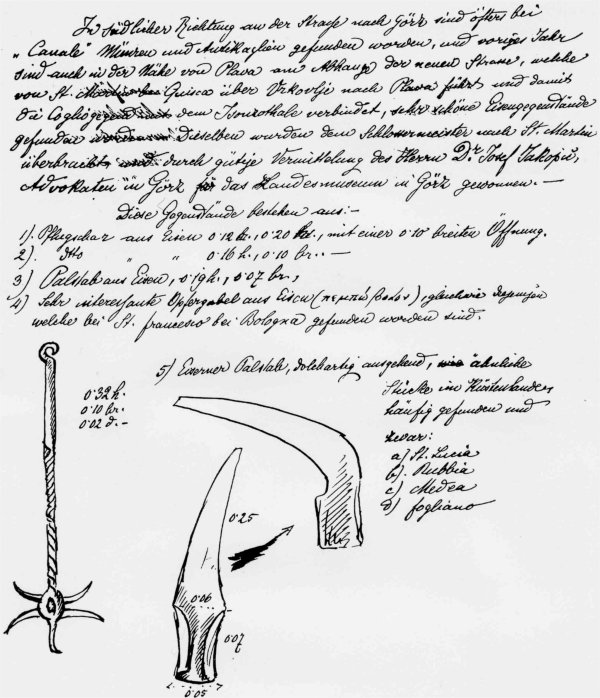
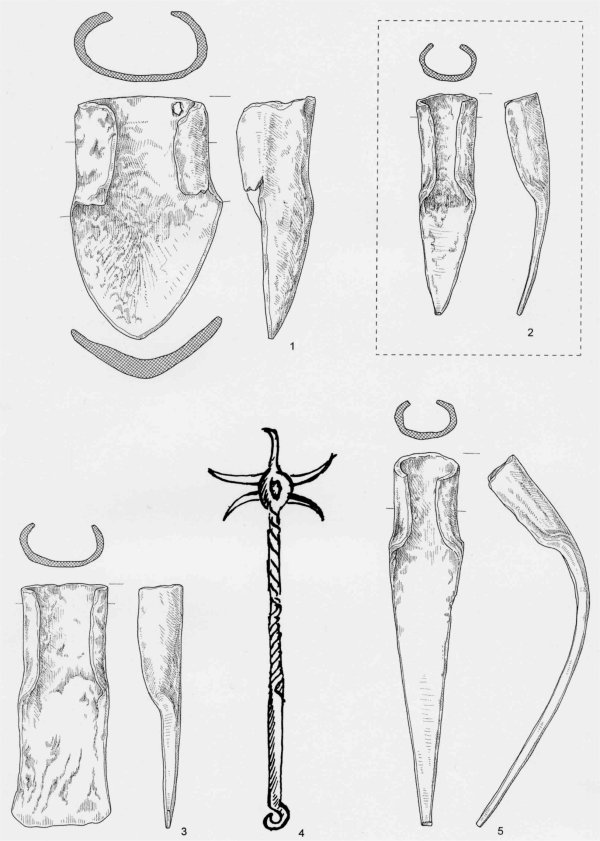
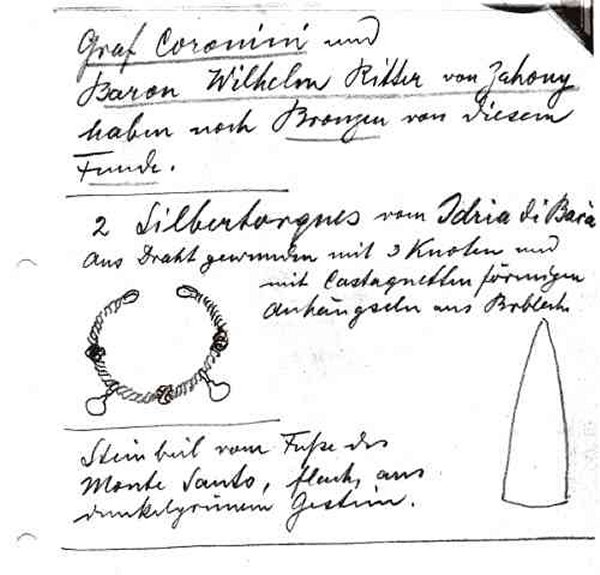 Page from the diary of Josef Szombathy with a sketch of one of the two silver torcs from Idrija pri Bači.
Page from the diary of Josef Szombathy with a sketch of one of the two silver torcs from Idrija pri Bači. Grave 14 from Repelc at Most na Soči with a pair of sheet earrings.
Grave 14 from Repelc at Most na Soči with a pair of sheet earrings.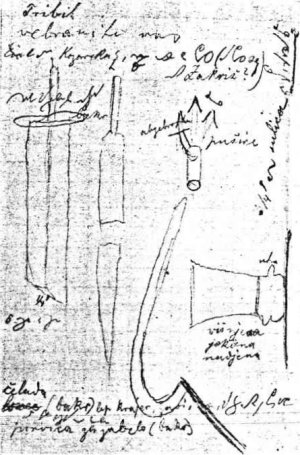 Zapiski Simona
Records of Simon Rutar on the discovery of graves at the site of Kozarska near Reka in the year 1883. Page from his pocket diary for the school year 1883/1884.
Zapiski Simona
Records of Simon Rutar on the discovery of graves at the site of Kozarska near Reka in the year 1883. Page from his pocket diary for the school year 1883/1884. 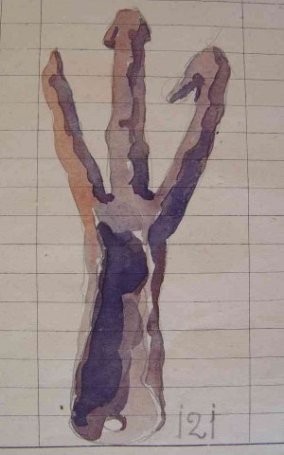 Trident from Reka, found in the year 1883. Watercolour of Giovanni Cossar, director of the Provincial Museum at Gorizia after the First World War.
Trident from Reka, found in the year 1883. Watercolour of Giovanni Cossar, director of the Provincial Museum at Gorizia after the First World War.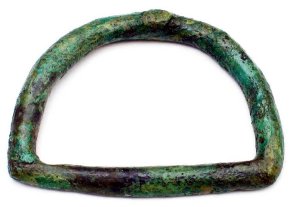 D-shaped buckle from the horse grave at Kobarid.
D-shaped buckle from the horse grave at Kobarid.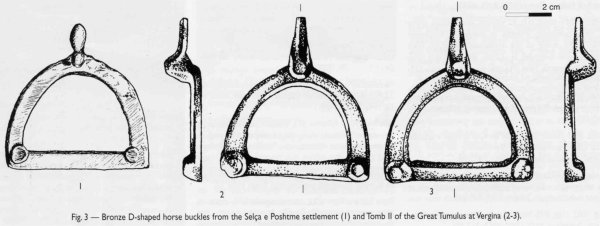 D-shaped buckles from the tomb of Philippus II at Vergina.
D-shaped buckles from the tomb of Philippus II at Vergina. 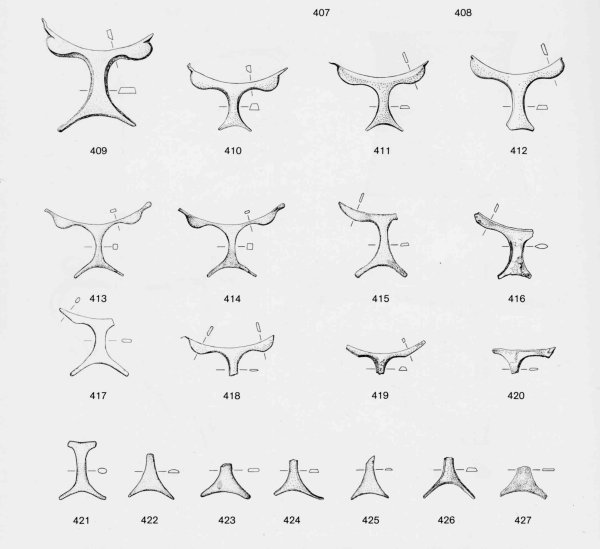 Late Republican thumb-rests from the oppidum of Manching.
Late Republican thumb-rests from the oppidum of Manching.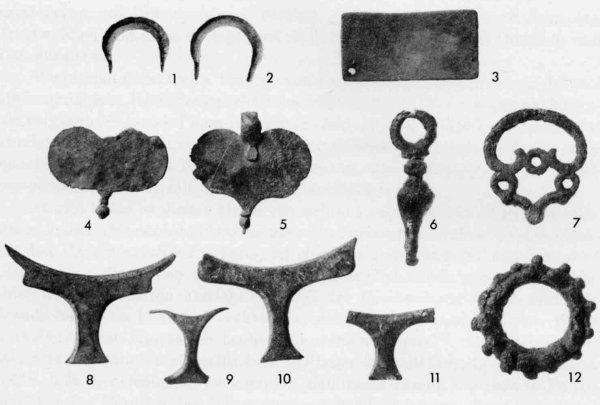 Early Imperial thumb-rests (nos. 8, 10 and 11) from the settlement Reichenbachwald on the site Engehalbinsel near Bern.
Early Imperial thumb-rests (nos. 8, 10 and 11) from the settlement Reichenbachwald on the site Engehalbinsel near Bern.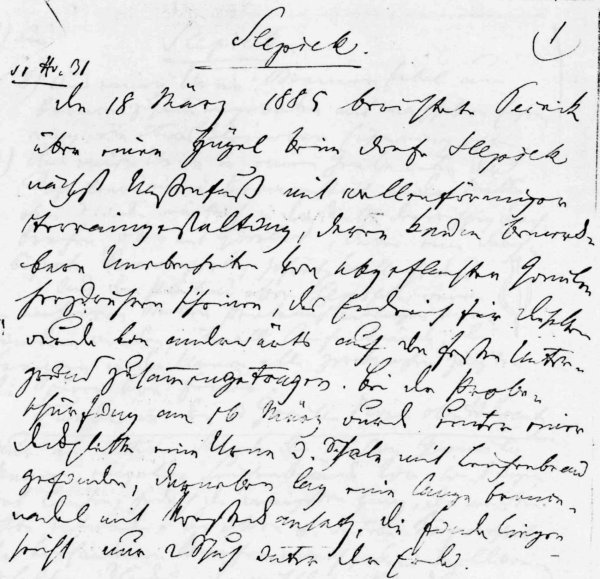 First page of Dežman's records on Pečnik's excavations near Mokronog.
First page of Dežman's records on Pečnik's excavations near Mokronog. 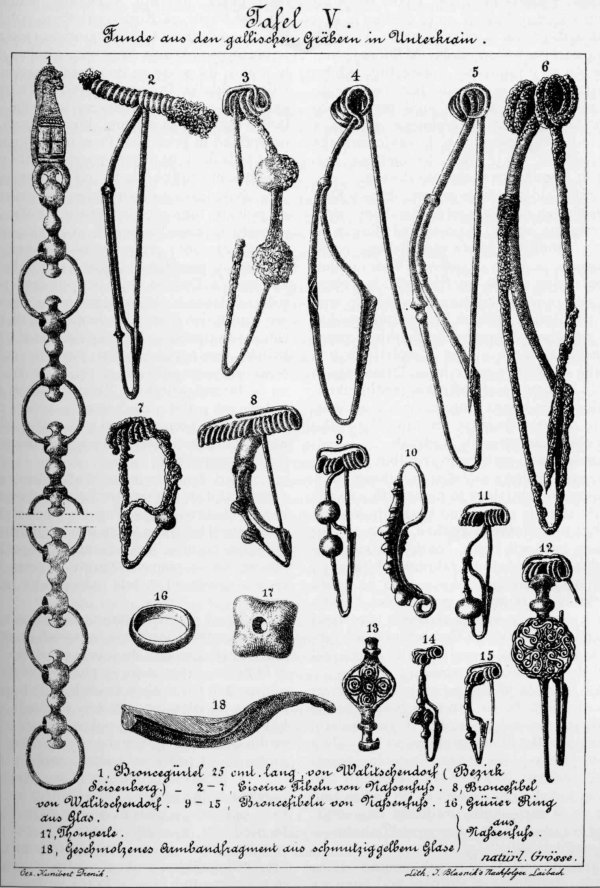 Drenik's drawing of the finds from the La Tène graves above Ribjek near Mokronog and near Valična vas.
Drenik's drawing of the finds from the La Tène graves above Ribjek near Mokronog and near Valična vas.